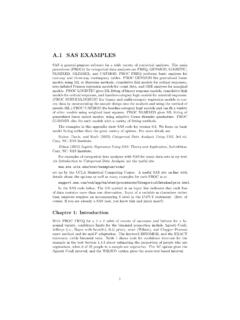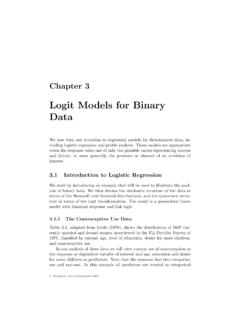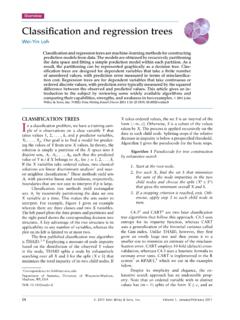Transcription of Maximum Likelihood Estimation of Logistic Regression ...
1 Maximum Likelihood Estimation of Logistic Regression Models: Theory and Implementation Scott A. Czepiel . Abstract This article presents an overview of the Logistic Regression model for dependent variables having two or more discrete categorical levels. The Maximum Likelihood equations are derived from the probability distribution of the dependent variables and solved using the Newton- Raphson method for nonlinear systems of equations. Finally, a generic implementation of the algorithm is discussed. 1 Introduction Logistic Regression is widely used to model the outcomes of a categorical dependent variable.
2 For categorical variables it is inappropriate to use linear Regression because the response values are not measured on a ratio scale and the error terms are not normally distributed. In addition, the linear Regression model can generate as predicted values any real number ranging from negative to positive infinity, whereas a categorical variable can only take on a limited number of discrete values within a specified range. The theory of generalized linear models of Nelder and Wedderburn [9]. identifies a number of key properties that are shared by a broad class of distributions.
3 This has allowed for the development of modeling techniques that can be used for categorical variables in a way roughly analogous to that in which the linear Regression model is used for continuous variables. Logistic Regression has proven to be one of the most versatile techniques in the class of generalized linear models. Whereas linear Regression models equate the expected value of the de- pendent variable to a linear combination of independent variables and their . Any comments or feedback concerning this article are welcome.
4 Please visit Maximum Likelihood Estimation of Logistic Regression Models 2. corresponding parameters, generalized linear models equate the linear com- ponent to some function of the probability of a given outcome on the de- pendent variable. In Logistic Regression , that function is the logit transform: the natural logarithm of the odds that some event will occur. In linear Regression , parameters are estimated using the method of least squares by minimizing the sum of squared deviations of predicted values from observed values.
5 This involves solving a system of N linear equations each having N. unknown variables, which is usually an algebraically straightforward task. For Logistic Regression , least squares Estimation is not capable of producing minimum variance unbiased estimators for the actual parameters. In its place, Maximum Likelihood Estimation is used to solve for the parameters that best fit the data. In the next section, we will specify the Logistic Regression model for a binary dependent variable and show how the model is estimated using max- imum Likelihood .
6 Following that, the model will be generalized to a depen- dent variable having two or more categories. In the final section, we outline a generic implementation of the algorithm to estimate Logistic Regression models. 2 Theory Binomial Logistic Regression The model Consider a random variable Z that can take on one of two possible values. Given a dataset with a total sample size of M , where each observation is independent, Z can be considered as a column vector of M binomial random variables Zi . By convention, a value of 1 is used to indicate success and a value of either 0 or 2 (but not both) is used to signify failure.
7 To simplify computational details of Estimation , it is convenient to aggregate the data such that each row represents one distinct combination of values of the in- dependent variables. These rows are often referred to as populations. Let N represent the total number of populations and let n be a column vector with elements ni representing PN the number of observations in population i for i = 1 to N where i=1 ni = M , the total sample size. Now, let Y be a column vector of length N where each element Y i is a random variable representing the number of successes of Z for population i.
8 Let the column vector y contain elements y i representing the observed counts of the number of successes for each population. Let be a column Scott A. Czepiel Maximum Likelihood Estimation of Logistic Regression Models 3. vector also of length N with elements i = P (Zi = 1|i), , the probability of success for any given observation in the i th population. The linear component of the model contains the design matrix and the vector of parameters to be estimated. The design matrix of independent variables, X, is composed of N rows and K + 1 columns, where K is the number of independent variables specified in the model .
9 For each row of the design matrix, the first element xi0 = 1. This is the intercept or the alpha.. The parameter vector, , is a column vector of length K + 1. There is one parameter corresponding to each of the K columns of independent variable settings in X, plus one, 0 , for the intercept. The Logistic Regression model equates the logit transform, the log-odds of the probability of a success, to the linear component: K. i X. log = xik k i = 1, 2, .. , N (1). 1 i k=0. Parameter Estimation The goal of Logistic Regression is to estimate the K + 1 unknown parameters in Eq.
10 1. This is done with Maximum Likelihood Estimation which entails finding the set of parameters for which the probability of the observed data is greatest. The Maximum Likelihood equation is derived from the probability distribution of the dependent variable. Since each y i represents a binomial count in the ith population, the joint probability density function of Y is: N. ni ! yi (1 i )ni yi Y. f (y| ) = (2). yi !(ni yi )! i i=1. For each population, there are nyii different ways to arrange yi successes . from among ni trials.









